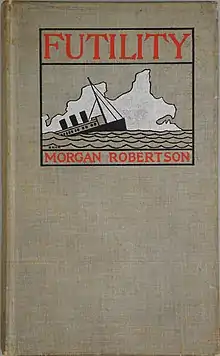The Wreck of the Titan: Or, Futility
Futility is a novella written by Morgan Robertson and published first during 1898. It was revised as The Wreck of the Titan in 1912. It features a fictional British ocean liner named Titan that sinks in the North Atlantic Ocean after striking an iceberg. The Titan and its sinking are famous for similarities to the passenger ship RMS Titanic and its sinking 14 years later. After the sinking of the Titanic the novel was reissued with some changes, particularly to the ship's gross tonnage.[1]
| Futility | |
|---|---|
 First edition, 1898 | |
| Author | Morgan Robertson |
| Country | United States |
| Language | English |
| Publication type | Novella |
| Publication date | 1898 |
| Text | Futility at Wikisource |
Plot
The first half of Futility introduces hero John Rowland, a disgraced former US Navy officer who was dismissed from the service. Now an alcoholic, he works as a deckhand on the Titan. One April night, the ship hits an iceberg and sinks, somewhat before the mid-point of the novel.
Rowland saves the young daughter of a former lover by jumping onto the iceberg with her. The pair find a lifeboat washed up on the iceberg and are rescued eventually by a passing ship. But the girl is recovered by her mother and Rowland is arrested for her kidnapping. A sympathetic magistrate discharges him and rebukes the mother for being unsympathetic to her daughter's savior. Rowland then begins living alone.
In a brief final chapter covering several years, Rowland progresses from homeless and largely anonymous fisherman to a desk job and finally, two years after passing a civil service exam, to "a lucrative position under the Government".
A later edition includes a followup: Rowland receives a letter from the mother (who congratulates him and pleads for him to visit her) and from the girl.
Similarities to the Titanic
Although the novel was written before the RMS Titanic was even conceptualized, there are some uncanny similarities between the fictional and real-life versions. Like the Titanic, the fictional ship sank after wrecking on an iceberg in April in the North Atlantic Ocean, and there were not enough lifeboats for all the passengers. The Titan would have survived a head-on collision with the iceberg, but a glancing encounter did more extensive damage. There are also similarities in size (800 ft [244 m] long for the Titan versus 882 ft 9 in [269 m] long for the Titanic), speed, and life-saving equipment.[2] After the Titanic's sinking, some people credited Robertson with precognition and clairvoyance, which he denied. Scholars attribute the similarities to Robertson's extensive knowledge of shipbuilding and maritime trends.[3]
In popular culture
- Walter Lord's book A Night to Remember (1955), relating the Titanic's wreck, begins with a summary of Robertson's novel.
- The American anthology series Beyond Belief: Fact or Fiction used the story in the episode eleven segment entitled "Titan".
- The comic À la recherche de Sir Malcolm (1984), by François Rivière and Floc'h, starts with an introduction which opens with a mention of Futility.
- The novel can be found sitting on Carlson's armchair in the 1996 video game Titanic: Adventure Out of Time.
- The 2010 Doctor Who audio drama The Wreck of the Titan by Barnaby Edwards connects the writing of Futility to the Titanic story through time travel.
- Martin Gardner's book The Wreck of the Titanic Foretold? (1986).
- The book was referenced in the television series One Step Beyond, in season 1, episode 2, entitled "Night of April 14th", which aired January 27, 1959.
- In The League of Extraordinary Gentlemen fictional universe, the Titan serves as the Titanic's fictional counterpart.
- Robertson's book is referenced in the 2009 video game Nine Hours, Nine Persons, Nine Doors in regards to the game's setting.
See also
- List of fictional ships
- Synchronicity
- How the Mail Steamer Went Down in Mid Atlantic by a Survivor – 1886 short story written to warn about ships which lack lifeboat capacity
References
- "The Titanic – Futility". History on the Net. 3 June 2014. Retrieved 2019-06-02.
- Roberts, Stephen (July 3, 2015). Titanic Foretold: The annotated version of Futility, or The Wreck of the Titan. Retrieved 2020-12-09.
- Hasan, Heba (April 14, 2012). "Author 'Predicts' Titanic Sinking, 14 Years Earlier". Time. Retrieved 2019-11-28.
Further reading
- Cocksey, Brian. "The Titan & the Titanic". Light Eternal Publishing Limited. Archived from the original on 2011-08-07. Retrieved 2005-11-23.
- Rutman, Sharon; Stevenson, Jay (1998). The Complete Idiot's Guide to the Titanic. Alpha Books. ISBN 0-02-862712-1.
- Flavio Cenni. "The Titanic before the Titanic". Retrieved 2009-01-13.
- Morgan Robertson, Stephen Roberts (2015). Titanic Foretold: The annotated version of Futility, or The Wreck of the Titan. Retrieved 2020-12-09.
External links
 The Wreck of the Titan public domain audiobook at LibriVox
The Wreck of the Titan public domain audiobook at LibriVox- The Wreck of the Titan by Morgan Robertson
- Online edition (250-page novel, 1912, facsimile edition)